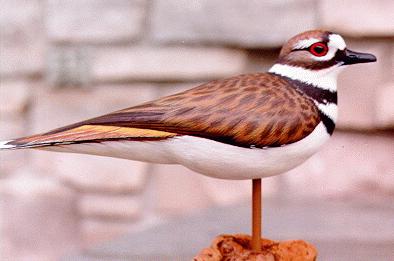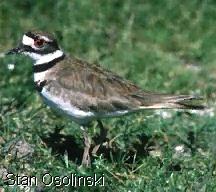


Killdeers breed throughout North America and in northwestern South America (and a few regularly visit Iceland and western Europe). They migrate only to escape snow, returning in spring before most songbirds. Killdeers are the ecologic equivalent of the lapwings of Europe. They eat beetles, grasshoppers, dragonflies, and other insects.
The nest is a scrape in the ground lined with pebbles. The male makes several such nests, and the female selects one of them. The eggs are four in number, grayish in colour, with black marks. The parents take turns incubating. Hatching takes place in 24 days. Both parents tend the chicks, which walk and feed themselves soon after hatching. Intruders are lured away from the nesting area by a "broken wing" distraction behaviour, in which a parent bird limps or flutters along the ground, appearing to be injured. The killdeer also attracts its mate's attention with a "broken wing" display in which it lies as if injured on the ground, with the "broken" wing outstretched.
"Killdeer," Microsoft(R) Encarta(R) 96 Encyclopedia. (c) 1993-1995 Microsoft Corporation. All rights reserved.
Museum of Natural History. All Rights Reserved.
